Permaculture companion plants for Chamomile
| Image | Name | Data | Description | Actions |
|---|---|---|---|---|

|
Allium cepa |
3-9
Annual
Full sun
Moist
Light (sandy), Medium
0.6
Herbs
Flowers, Leaves, Root, Seed
Seed - direct sow, Seed - transplant
https://en.wikipedia.org/wiki/Onion
Garden onion
Alliaceae
Zwiebel
https://pfaf.org/User/Plant.aspx?LatinName=Allium cepa
50°f, 10°c
Seed indoors 6 weeks before transplanting in the garden
2-6 inches
6.0-7.0
Allium
Turkmenistan
Algeria, Argentina Northeast, Arkansas, Baltic States, Bangladesh, Belarus, Bulgaria, California, Cambodia, Canary Is., Central European Rus, China North-Central, China South-Central, China Southeast, Colombia, Cuba, Czechoslovakia, Dominican Republic, East Aegean Is., East European Russia, East Himalaya, Ecuador, Egypt, Ethiopia, Fiji, France, Galápagos, Guinea-Bissau, Haiti, Illinois, India, Iraq, Italy, Jamaica, Kansas, Kentucky, Kirgizstan, Korea, Krym, Libya, Louisiana, Madeira, Manchuria, Mauritania, Mexico Central, Mexico Gulf, Mexico Northeast, Mexico Southeast, Mexico Southwest, Minnesota, Montana, Morocco, New York, Niue, North European Russi, Northwest European R, Oregon, Pakistan, Puerto Rico, Seychelles, South European Russi, Spain, Tadzhikistan, Texas, Thailand, Tibet, Tonga, Trinidad-Tobago, Ukraine, Uzbekistan, Vermont, Washington, West Himalaya, West Siberia, Wisconsin, Xinjiang, Yugoslavia
Spring or fall
0.3
https://powo.science.kew.org/taxon/urn:lsid:ipni.org:names:527795-1
Cosmetic, Dye, Hair, Polish, Rust
true
|
Onion (Allium cepa) is a plant species in the family Amaryllidaceae. It is native to central Asia and is commonly grown as a vegetable in many parts of the world. Onions are biennial plants, meaning they typically have a two-year life cycle. In the first year, the onion forms a small, rounded bulb with thin, papery skin. In the second year, the onion will produce a tall stem with hollow, elongated leaves and a small, spherical flower head. Onions are typically grown for their bulbs, which are used as a food ingredient in many dishes. The bulbs can vary in size and shape, depending on the variety, but are generally spherical or oblong in shape and range in size from about 2-4 inches in diameter. Onions are commonly differentiated by their color, which can range from white to yellow to red. Onions prefer well-drained soil that is rich in organic matter. They should be planted in a sunny location and will benefit from regular watering, especially during dry periods. Onion bulbs can be harvested when they reach the desired size, typically after about 100-150 days of growth. To store onions, they should be dried and cured in a cool, dry place for about two weeks before being placed in a mesh bag or other breathable container. Onions are edible and are commonly used as a food ingredient in many dishes. The bulbs are the most commonly used part of the plant, but the leaves and stems can also be used in cooking. Onions have a pungent, spicy flavor and are often used to add flavor to soups, stews, and other dishes. Onions can be stored for several months if properly dried and cured. In addition to their use as a food ingredient, onions have also been used for their medicinal properties. They have been used to treat a variety of ailments, including coughs, colds, and respiratory infections. Onions are also sometimes used as a natural fertilizer, due to the high levels of sulfur and other nutrients they contain. Onions are not known to provide significant value to wildlife. They are not a preferred food source for most animals and do not provide any significant habitat value. However, some insects, such as the onion maggot, can be pests of onion crops. |
Show
Edit |
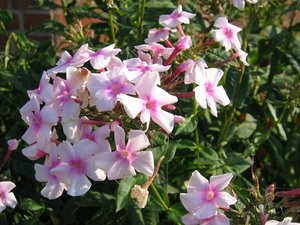
|
Phlox paniculata |
https://en.wikipedia.org/wiki/Phlox_paniculata
Medium
Moist
Full sun, Partial sun/shade
4-9
Fall phlox, perennial phlox, tall phlox, summer phlox
Light (sandy), Medium, Heavy (clay)
Polemoniaceae
1.2
Perennial
https://pfaf.org/User/Plant.aspx?LatinName=Phlox paniculata
Alabama, Arkansas, Connecticut, Delaware, District of Columbia, Georgia, Illinois, Indiana, Iowa, Kansas, Kentucky, Louisiana, Maine, Maryland, Massachusetts, Michigan, Minnesota, Mississippi, Missouri, Nebraska, New Hampshire, New Jersey, North Carolina, Ohio, Oklahoma, Pennsylvania, Rhode I., South Carolina, Tennessee, Utah, Vermont, Virginia, Washington, West Virginia
Central European Rus, Czechoslovakia, East European Russia, New Brunswick, New York, Newfoundland, Nova Scotia, Ontario, Primorye, Québec, Uzbekistan, Wisconsin
https://powo.science.kew.org/taxon/urn:lsid:ipni.org:names:193615-2
Fragrance
|
Show
Edit |
|
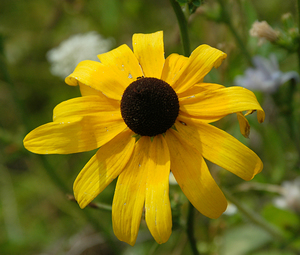
|
Black Eyed Susan |
4-9
Biennial, Perennial
Full sun, Partial sun/shade
Moist
Light (sandy), Medium, Heavy (clay)
04-0.9m
https://en.wikipedia.org/wiki/Rudbeckia_hirta
Medium
Coneflower, Gloriosa Daisy, Marguerite Jaune
Asteraceae or Compositae
Weed potential
https://pfaf.org/User/Plant.aspx?LatinName=Rudbeckia hirta
Roots
6.8-7.7
Alabama, Alberta, Arkansas, British Columbia, California, Colorado, Connecticut, Delaware, District of Columbia, Florida, Georgia, Idaho, Illinois, Indiana, Iowa, Kansas, Kentucky, Louisiana, Maine, Manitoba, Maryland, Massachusetts, Michigan, Minnesota, Mississippi, Missouri, Nebraska, New Brunswick, New Hampshire, New Jersey, New Mexico, New York, North Carolina, North Dakota, Nova Scotia, Ohio, Oklahoma, Ontario, Oregon, Pennsylvania, Prince Edward I., Québec, Rhode I., Saskatchewan, South Carolina, South Dakota, Tennessee, Texas, Utah, Vermont, Virginia, Washington, West Virginia, Wisconsin, Wyoming
Austria, Baltic States, Belarus, Belgium, Cuba, Czechoslovakia, East European Russia, France, Germany, Great Britain, Hungary, Ireland, Irkutsk, Italy, Japan, Kazakhstan, Kirgizstan, Korea, Krym, Kuril Is., Myanmar, Netherlands, Newfoundland, Norway, Poland, Primorye, Romania, South European Russi, Spain, Sweden, Switzerland, Turkmenistan, Ukraine, Uzbekistan, West Siberia, Yugoslavia
https://powo.science.kew.org/taxon/urn:lsid:ipni.org:names:223740-2
|
Black Eyed Susan (Rudbeckia hirta) is a flowering plant native to North America. It has a sturdy stem and can grow up to 2-3 feet tall. The leaves are green and lance-shaped, and the plant produces bright yellow or orange flowers with a dark center. The flowers bloom from mid to late summer. Black Eyed Susan prefers well-drained, moist soil and full sun to partial shade. It is a hardy plant and can tolerate a wide range of growing conditions. To cultivate it successfully, make sure the soil is adequately moist and provide sufficient sunlight. Black Eyed Susan is not known to be edible, but the plant has a number of uses. It is often grown for its attractive flowers, which can be used in bouquets and other floral arrangements. The plant is also beneficial for wildlife, providing food and shelter for a variety of animals. It is also known to have medicinal properties and has been used to treat a variety of ailments. |
Show
Edit |

|
Lungwort |
6-9
Partial sun/shade, Full shade
Moist
Light (sandy), Medium, Heavy (clay)
0.3
0.5
Perennial
Fast
true
Leaves
Common lungwort, jerusalem sage, jerusalem cowslip
Boraginaceae
Albania, Austria, Belarus, Belgium, Bulgaria, Czechoslovakia, Denmark, France, Germany, Greece, Hungary, Italy, Netherlands, Poland, Romania, Sweden, Switzerland, Ukraine, Yugoslavia
Great Britain, New York, Ontario, Québec
https://en.wikipedia.org/wiki/Pulmonaria_officinalis
https://pfaf.org/User/Plant.aspx?LatinName=Pulmonaria officinalis
https://powo.science.kew.org/taxon/urn:lsid:ipni.org:names:120402-1
Ground cover
|
Show
Edit |
|

|
Astilbe |
4-9
Full sun, Partial sun/shade
Moist
Light (sandy), Medium, Heavy (clay)
0.5
0.45
Perennial
Medium
true
Leaves
Saxifragaceae
Japan, Kuril Is.
https://en.wikipedia.org/wiki/Astilbe_thunbergii
https://pfaf.org/User/Plant.aspx?LatinName=Astilbe thunbergii
https://powo.science.kew.org/taxon/urn:lsid:ipni.org:names:790323-1
Tea
Dynamic accumulator
|
Show
Edit |
|
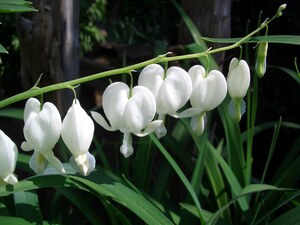
|
Bleeding Heart |
3-9
Full sun, Partial sun/shade
Moist
Light (sandy), Medium
0.6
Perennial
Medium
true
Leaves
Japanese bleeding heart, common bleeding heart
Papaveraceae
Korea, Manchuria
Czechoslovakia, Great Britain, New York, Primorye, Sweden, Uzbekistan
https://pfaf.org/User/Plant.aspx?LatinName=Dicentra spectabilis
https://powo.science.kew.org/taxon/urn:lsid:ipni.org:names:672659-1
Lamprocapnos spectabilis
https://powo.science.kew.org/taxon/urn:lsid:ipni.org:names:995841-1
|
Bleeding heart (Dicentra spectabilis) is a plant native to Asia, specifically in Japan, Korea, and China. It is a herbaceous perennial plant with delicate, fern-like foliage and arching stems that bear heart-shaped flowers in shades of pink and white. The flowers are typically nodding and have two outer petals that curve downwards and two inner petals that form a central "spur" or "point". The leaves are divided into many narrow, elongated leaflets. Bleeding heart grows to a height of about 1-2 feet and spreads to a width of about 1-2 feet as well. It is a slow-growing plant, but it can spread rapidly by forming underground rhizomes. It is often mistaken for other plants in the Dicentra genus, such as Dutchman's breeches (Dicentra cucullaria) and fringed bleeding heart (Dicentra eximia), which have similar heart-shaped flowers. Bleeding heart prefers partial to full shade and moist, well-draining soil. It does not tolerate drought well and should be watered regularly during dry spells. It is winter hardy in USDA hardiness zones 3-9, but the foliage will die back in the winter and the plant will go dormant. In the spring, new growth will emerge from the roots. The edible parts of bleeding heart are the young leaves and shoots, which can be cooked and eaten like spinach. The plant has a delicate, slightly bitter flavor and is rich in vitamins and minerals. The leaves and shoots can be stored in the refrigerator for a few days after harvest, or they can be blanched and frozen for longer storage. Bleeding heart has a number of uses in the garden. It is a popular ornamental plant, prized for its attractive flowers and delicate foliage. It is also a good ground cover plant and can be used in shade gardens, woodland gardens, and naturalized areas. It is not particularly useful for wildlife, although the flowers may be visited by hummingbirds and other nectar-seeking insects. In traditional medicine, bleeding heart has been used as a tonic and diuretic. It is also said to have mild sedative properties and has been used to treat anxiety and insomnia. However, the plant contains toxic alkaloids and should not be ingested in large quantities. |
Show
Edit |

|
Delphinium caeruleum |
Moist
Full sun
Light (sandy), Medium, Heavy (clay)
Ranunculaceae
0.3
6-9
Perennial
https://pfaf.org/User/Plant.aspx?LatinName=Delphinium caeruleum
China North-Central, China South-Central, East Himalaya, Myanmar, Nepal, Qinghai, Tibet, West Himalaya
https://powo.science.kew.org/taxon/urn:lsid:ipni.org:names:710459-1
Pest control
|
Show
Edit |
|
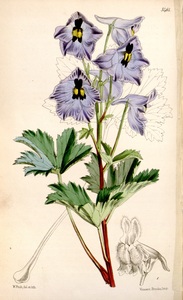
|
Delphinium brunonianum |
https://en.wikipedia.org/wiki/Delphinium_brunonianum
true
Moist
Full sun
4-8
Light (sandy), Medium, Heavy (clay)
Ranunculaceae
0.5
Oil
Perennial
https://pfaf.org/User/Plant.aspx?LatinName=Delphinium brunonianum
Afghanistan, Iran, Iraq, Nepal, Pakistan, Tadzhikistan, Tibet, West Himalaya
https://powo.science.kew.org/taxon/urn:lsid:ipni.org:names:710451-1
oil, Pest control, Fragrance
|
Show
Edit |
|

|
Delphinium cashmerianum |
true
Moist
Full sun
4-8
Light (sandy), Medium, Heavy (clay)
Ranunculaceae
0.5
Oil
Perennial
https://pfaf.org/User/Plant.aspx?LatinName=Delphinium cashmerianum
Nepal, Pakistan, Tibet, West Himalaya
https://powo.science.kew.org/taxon/urn:lsid:ipni.org:names:710482-1
oil, Pest control
|
Show
Edit |
|

|
Delphinium denudatum |
Dry, Moist
Full sun
Light (sandy), Medium, Heavy (clay)
Ranunculaceae
1.0
6-9
Perennial
https://pfaf.org/User/Plant.aspx?LatinName=Delphinium denudatum
Afghanistan, India, Pakistan, West Himalaya
https://powo.science.kew.org/taxon/urn:lsid:ipni.org:names:710557-1
Pest control
|
Show
Edit |
|

|
Rose |
2
Perennial
Full sun, Partial sun/shade
Deciduous
Shrubs
Animal feed, Attracts insects, Hedgerow, Wind breaker, Wildlife habitat
True
Fruit
Rosaceae
Zambia
https://powo.science.kew.org/taxon/urn:lsid:ipni.org:names:77120313-1
1
|
Show
Edit |
|
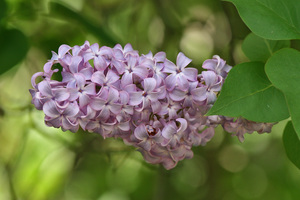
|
Lilac |
3-7
Full sun
Moist
Light (sandy), Medium, Heavy (clay)
Deciduous
6.0
4
Perennial
Shrubs
Medium
Dye, Essential Oil, Hedgerow, Rootstock, Fragrance
true
Flowers
Common lilac
true
Oleaceae
Albania, Bulgaria, Greece, Romania, Yugoslavia
Argentina South, Arizona, Arkansas, Austria, Belgium, British Columbia, Central European Rus, Colorado, Connecticut, Czechoslovakia, District of Columbia, East European Russia, France, Germany, Great Britain, Hungary, Illinois, Indiana, Iowa, Ireland, Italy, Kansas, Kentucky, Korea, Krym, Maine, Maryland, Massachusetts, Michigan, Minnesota, Missouri, New Brunswick, New Hampshire, New Jersey, New Mexico, New York, North Carolina, Nova Scotia, Ohio, Oklahoma, Ontario, Pennsylvania, Poland, Primorye, Prince Edward I., Québec, Rhode I., Saskatchewan, South Dakota, South European Russi, Spain, Switzerland, Tennessee, Utah, Vermont, Virginia, West Virginia, Wisconsin
https://en.wikipedia.org/wiki/Syringa_vulgaris
https://pfaf.org/User/Plant.aspx?LatinName=Syringa vulgaris
https://powo.science.kew.org/taxon/urn:lsid:ipni.org:names:289009-2
True
|
Show
Edit |
|

|
Ninebark |
https://en.wikipedia.org/wiki/Physocarpus_opulifolius
Medium
Moist
Full sun
3-7
Shrubs
Common ninebark, atlantic ninebark
Light (sandy), Medium, Heavy (clay)
Rosaceae
3.0
https://pfaf.org/User/Plant.aspx?LatinName=Physocarpus opulifolius
Alabama, Arizona, Connecticut, Delaware, District of Columbia, Florida, Georgia, Illinois, Indiana, Iowa, Kansas, Kentucky, Maine, Maryland, Massachusetts, Michigan, Minnesota, Mississippi, Nebraska, New Brunswick, New Hampshire, New Jersey, New York, North Carolina, North Dakota, Nova Scotia, Ohio, Oklahoma, Ontario, Pennsylvania, Québec, Rhode I., South Carolina, South Dakota, Tennessee, Vermont, Virginia, West Virginia, Wisconsin
Albania, Belgium, Bulgaria, Central European Rus, East European Russia, Korea, Primorye, Romania
https://powo.science.kew.org/taxon/urn:lsid:ipni.org:names:1115316-2
|
Show
Edit |
|

|
Dogwood |
https://en.wikipedia.org/wiki/Cornus_sanguinea
true
Moist
Full sun, Partial sun/shade
4-8
Shrubs
Bloodtwig dogwood
Light (sandy), Medium, Heavy (clay)
Cornaceae
3.0
Oil
Fruit
https://pfaf.org/User/Plant.aspx?LatinName=Cornus sanguinea
Albania, Austria, Baltic States, Belarus, Belgium, Bulgaria, Central European Rus, Corse, Czechoslovakia, Denmark, East European Russia, France, Germany, Great Britain, Greece, Hungary, Ireland, Italy, Krym, Lebanon-Syria, Netherlands, North Caucasus, North European Russi, Northwest European R, Norway, Poland, Portugal, Romania, Sardegna, Sicilia, South European Russi, Spain, Sweden, Switzerland, Transcaucasus, Turkey, Turkey-in-Europe, Ukraine, Yugoslavia
Massachusetts, Pennsylvania, Washington
https://powo.science.kew.org/taxon/urn:lsid:ipni.org:names:271661-1
Weaving material, Fire starter, Dye, Hedgerow, oil, Lumber, Fragrance
|
Show
Edit |
|

|
Apple |
3-8
Full sun, Partial sun/shade
Moist
Light (sandy), Medium, Heavy (clay)
Deciduous
10.0
9
Perennial
Trees
Animal feed, Attracts insects, Hedgerow
True
Fruit
Oil
Appel
Æble
Rosaceae
Malus
Afghanistan, Kazakhstan, Kirgizstan, Pakistan, Tadzhikistan, Uzbekistan, Xinjiang
Alabama, Alaska, Albania, Argentina Northeast, Argentina South, Arkansas, Azores, Baleares, Baltic States, Belarus, Belgium, British Columbia, Bulgaria, California, Central European Rus, Colorado, Connecticut, Cyprus, Czechoslovakia, Delaware, Denmark, District of Columbia, East European Russia, East Himalaya, Ecuador, Falkland Is., Finland, France, Georgia, Germany, Great Britain, Greece, Hungary, Illinois, Indiana, Iowa, Iraq, Ireland, Italy, Kansas, Kentucky, Korea, Krym, Louisiana, Madeira, Maine, Manitoba, Maryland, Massachusetts, Michigan, Minnesota, Mississippi, Missouri, Montana, Nebraska, Nepal, Netherlands, Nevada, New Brunswick, New Hampshire, New Jersey, New Mexico, New South Wales, New York, Newfoundland, North Carolina, North Caucasus, North Dakota, Norway, Nova Scotia, Ohio, Ontario, Oregon, Pennsylvania, Poland, Prince Edward I., Québec, Rhode I., Romania, South Carolina, South European Russi, Spain, Sweden, Tasmania, Tennessee, Turkmenistan, Ukraine, Utah, Vermont, Victoria, Virginia, West Virginia, Wisconsin, Wyoming, Yugoslavia
https://en.wikipedia.org/wiki/Apple
https://pfaf.org/user/plant.aspx?LatinName=Malus+domestica
https://powo.science.kew.org/taxon/urn:lsid:ipni.org:names:726282-1
Apfel
|
An apple is an edible fruit produced by an apple tree (Malus domestica). Apple trees are cultivated worldwide and are the most widely grown species in the genus Malus. The tree originated in Central Asia, where its wild ancestor, Malus sieversii, is still found today. Apples have been grown for thousands of years in Asia and Europe and were brought to North America by European colonists. Apples have religious and mythological significance in many cultures, including Norse, Greek, and European Christian tradition. Apples grown from seed tend to be very different from those of their parents, and the resultant fruit frequently lacks desired characteristics. Generally, apple cultivars are propagated by clonal grafting onto rootstocks. Apple trees grown without rootstocks tend to be larger and much slower to fruit after planting. Rootstocks are used to control the speed of growth and the size of the resulting tree, allowing for easier harvesting. There are more than 7,500 known cultivars of apples. Different cultivars are bred for various tastes and uses, including cooking, eating raw, and cider production. Trees and fruit are prone to a number of fungal, bacterial, and pest problems, which can be controlled by a number of organic and non-organic means. In 2010, the fruit's genome was sequenced as part of research on disease control and selective breeding in apple production. Worldwide production of apples in 2018 was 86 million tonnes, with China accounting for nearly half of the total. From [Wikipedia](https://en.wikipedia.org/wiki/Apple) |
Show
Edit |

|
Cabbage |
7-11
Biennial
Full sun, Partial sun/shade
Moist
Light (sandy), Medium, Heavy (clay)
0.8
true
Leaves, Seed
https://en.wikipedia.org/wiki/Cabbage
Medium
Ornamental cabbage, red cabbage, savoy cabbage
Brassicaceae or cruciferae
https://pfaf.org/User/Plant.aspx?LatinName=Brassica oleracea capitata
3 to 7 years
Dye, Dynamic accumulator
|
Cabbage (Brassica oleracea capitata) is a biennial plant that is native to the Mediterranean region. It is a member of the Brassicaceae or mustard family and is closely related to other brassica crops such as broccoli, cauliflower, and Brussels sprouts. Cabbage is a leafy green plant that typically grows to about 1-2 feet in height. The leaves are large, thick, and vary in color depending on the variety of cabbage, with common colors including green, red, and purple. The plant produces small, yellow flowers that form in dense clusters at the top of the plant. Cabbage is a fast-growing plant that can be grown in a variety of conditions. It prefers well-draining soil that is rich in organic matter and full sun to partial shade. To successfully cultivate cabbage, a grower will need to water the plants regularly, especially during dry periods, and may need to use row covers to protect the plants from pests. Cabbage is an edible plant and all parts of the plant are edible. The leaves are the most commonly eaten part of the plant and can be eaten raw or cooked. The leaves can be stored in the refrigerator for several days after harvest. Cabbage can also be preserved by fermenting it to make sauerkraut or by pickling it. Cabbage is a valuable plant for gardeners and farmers because it is a nutritious and versatile food. It is high in vitamins C and K and contains significant amounts of dietary fiber. In addition to being eaten as a vegetable, cabbage can be used for medicinal purposes, as a fertilizer, and as a companion plant to repel pests in the garden. It is also a valuable food source for many species of wildlife. |
Show
Edit |

|
Kale |
5-10
Full sun, Partial sun/shade
Moist
Light (sandy), Medium, Heavy (clay)
6.0-6.8
Deciduous
0.9
Biennial, Perennial
Herbs
Fast
45cm
Seed - direct sow, Seed - transplant
At last frost date
4-6 weeks before last frost
7-10 days
3 to 7 years
Dynamic accumulator
true
Shoots
Brassicaceae, Cruciferae
True
https://en.wikipedia.org/wiki/Kale
https://pfaf.org/User/Plant.aspx?LatinName=Brassica oleracea acephala
Shallow
0.5 cm
60
|
Kale (/keɪl/) is a hardy, leafy green vegetable that is a member of the Brassica oleracea species. It is native to the eastern Mediterranean and Asia Minor, and has been cultivated for food for over 2000 years. Kale plants typically have green or purple leaves that are deeply lobed and can grow up to 2 feet in length. The leaves are attached to a central stem and don't make a head, and the plant produces small, yellow flowers. Kales are considered to be closer to wild cabbage than most of the many domesticated forms of Brassica oleracea. In terms of growing conditions, kale prefers cool weather and does well in full sun to partial shade. It can be grown year-round in mild climates, but in colder climates it is best grown in the fall and early spring. To cultivate kale successfully, it is important to provide the plants with plenty of moisture and to regularly fertilize them. Kale is also a good companion plant for other vegetables, as it can help to deter pests and improve the health of the soil. In terms of edibility, kale is highly nutritious and can be eaten raw or cooked. The leaves and stems are both edible, and the plant can be stored in the refrigerator for several days after harvest. Kale can be used in a variety of dishes, including soups, salads, and smoothies. It can also be cooked and served as a side dish, or used as a garnish. In addition to its culinary uses, kale has a number of other uses. It is often used as a cover crop, as it can help to improve the fertility of the soil. Kale leaves can also be used as a mulch, as they break down readily and release nutrients into the soil. Additionally, kale plants can be used for wind protection, as their large leaves and sturdy stems can provide a barrier to wind. ### Links [Kale @ West Coast Seeds](https://www.westcoastseeds.com/blogs/how-to-grow/grow-kale-collards) |
Show
Edit |
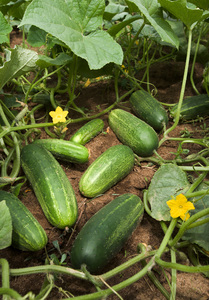
|
Cucumis sativus |
9-11
Annual
Full sun
Moist
Light (sandy), Medium, Heavy (clay)
2
Vines
Fruit, Leaves, Seed
Seed - direct sow, Seed - transplant
1 week after last frost
https://en.wikipedia.org/wiki/Cucumber
Cucurbitaceae
Gurke
50-65
23cm
6.0-6.8
15-30°C (60-85°F)
https://pfaf.org/User/Plant.aspx?LatinName=Cucumis sativus
True
Fruit
Assam, Bangladesh, China South-Central, China Southeast, East Himalaya, Myanmar, Nepal, Thailand, West Himalaya
Alabama, Albania, Andaman Is., Arizona, Arkansas, Austria, Bahamas, Bolivia, Caroline Is., Cayman Is., Colombia, Costa Rica, Cuba, Czechoslovakia, Denmark, Dominican Republic, Ecuador, Florida, Georgia, Gulf of Guinea Is., Haiti, Illinois, India, Jamaica, Kansas, Kazakhstan, Kentucky, Korea, Laos, Leeward Is., Louisiana, Marianas, Marshall Is., Massachusetts, Michigan, Mississippi, Missouri, New Caledonia, New York, Nicaragua, Nicobar Is., North Carolina, North Caucasus, Ohio, Oman, Ontario, Pakistan, Pennsylvania, Pitcairn Is., Puerto Rico, South Carolina, Sri Lanka, Sweden, Tadzhikistan, Trinidad-Tobago, Turkmenistan, Utah, Uzbekistan, Venezuela, Vietnam, Virginia, Windward Is., Zaïre
2-3 weeks before last frost
1 week after last frost
0.9
https://powo.science.kew.org/taxon/urn:lsid:ipni.org:names:292296-1
Oil
Cosmetic, oil
true
|
Cucumber, scientific name Cucumis sativus, is a member of the gourd family. It is native to India and other parts of Asia. Cucumber is a trailing or climbing plant that grows to a height of 5-10 feet. The leaves are dark green and glossy, and the plant produces yellow flowers. The fruit of the cucumber plant is a long, green, edible vegetable with a thin skin. Cucumbers are typically about 6-9 inches long and 2-3 inches in diameter. In terms of growth and cultivation, cucumber plants prefer warm, sunny conditions and well-draining soil. They should be watered regularly, especially during dry periods. Cucumber plants are not winter hardy and should be grown in the summer months in most climates. To cultivate cucumbers successfully, it is important to provide them with adequate space to grow and to support the plants with trellises or other means to keep the fruits off the ground. The plant will develop male and female flowers. You can recognize the female by having a tiny cucumber underneath. Sometimes the plant develops a lot of male flowers first, so be patient. If you don’t see any bees pollinating. Take a male and put it on all the female flowers. Cucumber fruits are edible and can be eaten raw, pickled, or cooked. The skin and seeds of the cucumber are edible, but some people choose to remove the seeds before eating the fruit. Cucumber fruits can be stored in the refrigerator for a few days after harvest. Cucumbers have several uses. In addition to being eaten as a vegetable, they can also be used in a variety of dishes and salads. Cucumber slices are often used as a garnish or as a refreshing addition to beverages. Cucumbers are also commonly used in natural skin care products and are believed to have anti-inflammatory and soothing properties. #### Propagation Direct sow when soil is warm enough in early summer. Sow seeds individually indoors 3-4 weeks before planting outside into warm soil. Use bottom heat if possible. Transplant when plants develop third leaf. #### Medicinal Fruit is depurative, diuretic, emollient, purgative and resolvent #### Links [Cucumber @ West Coast Seeds](https://www.westcoastseeds.com/products/patio-snacker) |
Show
Edit |

|
Broccoli |
2-11
Full sun, Partial sun/shade
Moist
Light (sandy), Medium, Heavy (clay)
6.0-7.0
0.9
Annual, Biennial
45cm
6-8 weeks before last frost
7-10 days
4°C (40°F)
50-100
3 to 7 years
Companion
true
Flowers, Leaves, Shoots
Brokkoli
Brassicaceae or Cruciferae
https://pfaf.org/User/Plant.aspx?LatinName=Brassica oleracea italica
|
Broccoli is a plant that is native to the Mediterranean region. It is part of the Brassica oleracea family, which also includes other vegetables such as cauliflower and cabbage. Broccoli plants have green, flowering heads that are similar in appearance to cauliflower. The stems are typically thick and can grow to be quite large, depending on the variety of broccoli. The leaves of the plant are typically dark green and are arranged in a spiral pattern along the stem. When it comes to growing conditions, broccoli prefers cool weather and well-draining soil. It is a relatively fast-growing plant, with the flowering heads typically forming in the first year. To cultivate broccoli successfully, a grower will need to make sure the plant gets enough water and sunlight, and provide it with the necessary nutrients through fertilization. In terms of winter hardiness, broccoli is not very frost-tolerant, so it is typically grown as a cool-season crop in areas with mild winters. In terms of edibility, broccoli is a very nutritious vegetable that is packed with vitamins and minerals. The flowering heads and the stems are both edible, and can be cooked in a variety of ways. After harvest, broccoli can be stored in the refrigerator for several days, or frozen for longer-term storage. ### Propagation - Direct sow Sow seeds 7cm apart, thin when seedlings reach 5-7cm in height. ### Propagation - Transplant Start seeds 6-8 weeks before your last frost date, or 2-3 weeks before last frost date. Plant outside when seedlings are 4-6 weeks old, or have 4-5 leaves. #### Links [Broccoli @ Almanac](https://www.almanac.com/plant/broccoli) |
Show
Edit |

|
Brussel Sprouts |
Full sun, Partial sun/shade
Moist
Light (sandy), Medium, Heavy (clay)
1.2
0.2
Biennial
3 to 7 years
true
Leaves
Rosenkohl
Brassicaceae or cruciferae
https://pfaf.org/User/Plant.aspx?LatinName=Brassica oleracea gemmifera
|
A leaf vegetable in the cabbage family. |
Show
Edit |

|
Cauliflower |
3-10
Full sun, Partial sun/shade
Moist
Light (sandy), Medium, Heavy (clay)
0.8
Annual, Biennial
3-7 years
Companion, antifungal, Dynamic accumulator
true
Flowers, Leaves
Blumenkohl
Brassicaceae or cruciferae
https://pfaf.org/User/Plant.aspx?LatinName=Brassica oleracea botrytis
|
Annual plant reproduced by seed. |
Show
Edit |

|
Kohlrabi |
4-8
Full sun, Partial sun/shade
Moist
Light (sandy), Medium, Heavy (clay)
0.5
Annual, Biennial
Fast
true
Leaves, Stem
German turnip
Kohlrabi
Brassicaceae or cruciferae
https://pfaf.org/User/Plant.aspx?LatinName=Brassica oleracea gongylodes
|
Show
Edit |
|
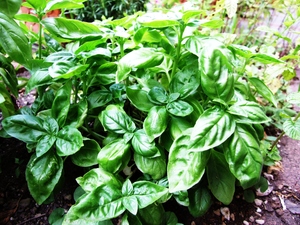
|
Basil |
5-10
Annual, Perennial
Full sun
Moist
Light (sandy), Medium
0.5
Herbs
true
Leaves, Seed
Seed - direct sow
https://en.wikipedia.org/wiki/Basil
Fast
Common basil, Thai basil, Tropical basil
Lamiaceae or labiatae
Basilikum
https://pfaf.org/User/Plant.aspx?LatinName=Ocimum basilicum
Start indoors from late february to mid-summer
Can be grown in containers
1.1
Andaman Is., Assam, Bangladesh, Bismarck Archipelago, Borneo, Cambodia, China South-Central, China Southeast, East Himalaya, India, Jawa, Laos, Lesser Sunda Is., Malaya, Maluku, Myanmar, Nepal, New Guinea, Nicobar Is., Philippines, Queensland, Sri Lanka, Sulawesi, Sumatera, Taiwan, Thailand, Vietnam, West Himalaya, Western Australia
Angola, Bahamas, Benin, Bolivia, Brazil Southeast, Bulgaria, Burkina, Burundi, Cameroon, Canary Is., Cape Provinces, Cape Verde, Caroline Is., Cayman Is., Central African Repu, Chad, Colombia, Comoros, Congo, Cook Is., Cuba, Dominican Republic, East Aegean Is., Ecuador, El Salvador, Eritrea, Ethiopia, Fiji, Gabon, Gambia, Ghana, Gilbert Is., Guatemala, Guinea, Guinea-Bissau, Gulf of Guinea Is., Haiti, Hawaii, Honduras, Illinois, Ivory Coast, Jamaica, Kazakhstan, Kenya, Laccadive Is., Leeward Is., Liberia, Line Is., Madagascar, Malawi, Maldives, Mali, Marianas, Marquesas, Marshall Is., Mexico Central, Mexico Gulf, Mexico Northeast, Mexico Northwest, Mexico Southeast, Mexico Southwest, Mongolia, Mozambique, Nauru, New Caledonia, New York, Nicaragua, Niger, Nigeria, Niue, Oman, Panamá, Primorye, Puerto Rico, Romania, Samoa, Senegal, Sierra Leone, Society Is., South Australia, South European Russi, Sudan, Tanzania, Tokelau-Manihiki, Tonga, Trinidad-Tobago, Tuamotu, Uganda, Ukraine, Venezuela, Venezuelan Antilles, Wallis-Futuna Is., Windward Is., Xinjiang, Zambia, Zaïre, Zimbabwe
After last frost date
15cm
https://powo.science.kew.org/taxon/urn:lsid:ipni.org:names:452874-1
Condiment, Drink, Tea
Essential Oil, Strewing, Fragrance
|
Basil (Ocimum basilicum) is a herb native to tropical regions of Asia and Africa. It is known for its fragrant, green leaves and small, white flowers. The leaves are typically oval-shaped and have a glossy texture. The stem is typically square-shaped and can grow up to 24 inches tall. Basil is a fast-growing plant that prefers full sun and well-drained soil. In colder climates, it is typically grown as an annual, as it is not winter hardy. To cultivate basil successfully, a grower should water it regularly and provide adequate drainage. Removing the last pair of leaves encourages branching and growth. Basil is often differentiated from other plants by its distinctive aroma, which is used in a wide variety of dishes, including pesto, soups, and salads. The leaves, flowers, and stems of the basil plant are all edible, and can be stored by drying or freezing. In addition to its culinary uses, basil has a number of other uses. It has been used medicinally as an anti-inflammatory and to improve digestion. It is also known to attract bees and other pollinators, making it valuable for gardens. |
Show
Edit |
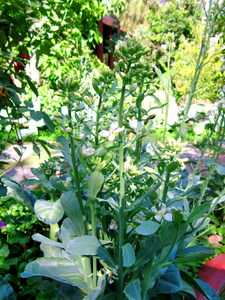
|
Gai lan |
Annual, Perennial
Full sun
Moist
20-48cm
Leaves
Seed - direct sow, Seed - transplant
1-2 weeks after last frost date
https://en.wikipedia.org/wiki/Gai_lan
Kai lan, Kailaan, Chinese broccoli, Chinese kale
30x30cm
10-30°c (50-85°f)
7-10 days
6.0-6.8
60-70
Fast
Brassicaceae
France, Great Britain, Spain
Albania, Algeria, Antipodean Is., Assam, Azores, Baltic States, Bangladesh, Belarus, Belgium, Bulgaria, California, Canary Is., Caroline Is., Central European Rus, Chatham Is., Chile South, China North-Central, China South-Central, China Southeast, Connecticut, Costa Rica, Crozet Is., Czechoslovakia, East European Russia, East Himalaya, Easter Is., Ecuador, El Salvador, Ethiopia, Falkland Is., Germany, Greece, Guatemala, Illinois, India, Iowa, Iraq, Juan Fernández Is., Kazakhstan, Kentucky, Kenya, Korea, Krym, Labrador, Lebanon-Syria, Libya, Madeira, Marianas, Marshall Is., Maryland, Massachusetts, Morocco, Netherlands, New Caledonia, New South Wales, New York, New Zealand North, New Zealand South, Newfoundland, North European Russi, Northern Territory, Northwest European R, Ohio, Ontario, Oregon, Pennsylvania, Prince Edward I., Queensland, Québec, Rhode I., Sardegna, Saudi Arabia, South Australia, South European Russi, Tadzhikistan, Tanzania, Tasmania, Texas, Trinidad-Tobago, Tunisia, Turkmenistan, Ukraine, Vermont, Victoria, Vietnam, Washington, Western Australia, Zaïre
Brassica oleracea
https://powo.science.kew.org/taxon/urn:lsid:ipni.org:names:279435-1
2-4 weeks before last frost date
At last frost date
3 to 7 years
https://powo.science.kew.org/taxon/urn:lsid:ipni.org:names:2934780-4
|
Can be grown as a perennial by cutting only 5cm above ground and leave root ball intact. Harvest before plants start to bolt and create buds/flowers. |
Show
Edit |

|
Allium cepa ascalonicum |
4-8
Full sun
Moist
Light (sandy), Medium
5.0-7.0
0.3
0.2
Herbs
25cm, 10inch
Seed - direct sow
mid-Nov. - mid-March
Flowers, Leaves, Root
Alliaceae, Liliaceae
https://en.wikipedia.org/wiki/Shallot
https://pfaf.org/User/Plant.aspx?LatinName=Allium cepa ascalonicum
Cosmetic, Dye, Hair, Polish, Rust
true
|
Easy to grow vegetable that grow from a bulb. Edible parts are used for cooking. Exists in many varieties. Grows well in any fertile, well-drained soil at a sunny spot. Is started from seeds or sets (immature bulbs). Has a long growing period. |
Show
Edit |